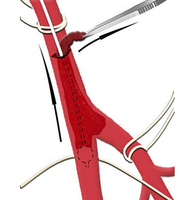








The Balloon Embolectomy Catheter is a great example of simple inventions resulting in a powerful medical breakthrough. This invention pioneered minimally invasive vascular surgery, and extended life saving procedures to ten's of millions of people.
During Fogarty’s years at Good Samaritan Hospital, he witnessed the deaths of many patients who died from complications in blood clot surgeries in their limbs. “Fifty percent of the patients died. I thought there must be a better way.”Before Fogarty’s invention, surgeons had to use forceps to remove the blood clots only after a huge part of an artery had been cut open, and the patient would be under general anesthesia for hours. Blood flow is usually interrupted in the procedure, increasing the risk of the patient losing a limb.
At home, the ideas that went through Fogarty’s head concerned different ways of making the procedure better, and he especially concentrated on avoiding the risky incisions. He tinkered with a urethral catheter and a balloon in his attic. Because a catheter only required a small incision, it would be able to get to the clot without much trauma to the patient. The urethral catheter is also flexible yet strong enough to be pushed through a blood clot. As for the balloon, he basically cut off the tip of the pinky finger of a size 5 surgical latex glove and attempted to incorporate it onto the end of the catheter. The resulting balloon could be inflated with saline using a syringe, and once it expands to the size of the artery, it is then retracted, withdrawing the clot through the artery and out the incision.
The main problem in building this device was the way the balloon could be attached to the catheter. Glue that could hold vinyl, the material making up a catheter, and latex, the type of glove used, was not available. Fogarty’s own take on the catheter came about because of fly fishing techniques he learned as a child. Precise hand-tying was needed in fly fishing, and with these techniques, he tied the balloon to the catheter. "I'd always tied flies and made lures so it was just a natural thing."His experimental balloon catheter, however, always seemed to burst when it was over inflated. It even broke when he dragged it through glass tubes filled with Jell-o, a model he thought simulated a clot within an artery. After some time, he figured out the type and thickness of rubber that was firm enough when inflated to extract a clot and still flexible enough to move through without breaking. The device, made before Fogarty even received his MD from University of Cincinnati in 1960, became the first minimally invasive surgical device.
Fogarty, however, came across difficulties in getting a manufacturer to produce it. From 1959 to 1961, nobody was willing to help. "Companies thought I was some stooge fooling around. I didn't have any credibility."Dr. Cranley continued to encourage him, and soon, during his fellowship training at the University of Cincinnati in 1961 and 1962, Fogarty started to make the catheter system by hand for himself and for other vascular surgeons.
At the University of Oregon, while Fogarty was completing his residency in surgery, Dr. Al Starr, head of the cardiothoracic division, used Fogarty’s balloon catheters. After he was informed that no company was willing to manufacture Fogarty’s device, he asked one of his acquaintances, Lowell Edwards, an electrical engineer and president of his own company, to give the device consideration in producing it. In 1969, Fogarty patented his device, and Edwards Life Sciences from Irvine, California, was assigned the patent to begin manufacturing the Fogarty embolectomy catheter.
Because of the decreased risk associated with the device, it became the industry standard. It is still the most widely used catheter for blood-clot removal today and has been used in over three hundred thousand procedures every year all over the world.It is estimated to have saved the lives and limbs of approximately fifteen million patients.